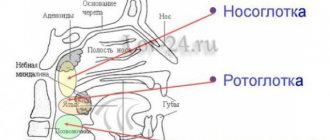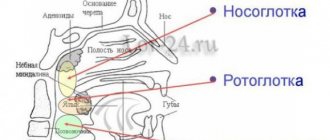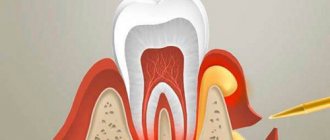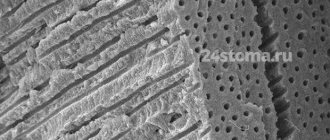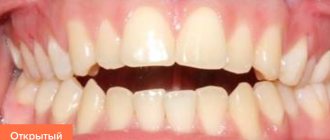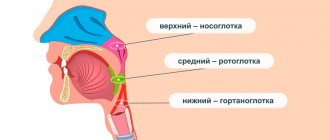Tooth dentin: what is it, composition and structure
Dentin is a hard tissue located under the cement and enamel of teeth, respectively, in the roots and crown. It has a special structure and is second only to enamel in strength. Such properties are provided by a unique biochemical composition, which is represented by organic (20% by weight) and inorganic (70%) compounds, water (10%). The thickness of the dentin layer ranges from 2 to 6 mm. In the cervical region it is smallest. Its structure is presented in the following table:
| Types of fabric | Layer Features | Functionality |
| Dentinal tubules and tubules | Permeate the entire structure | The fibers that fill these elements are responsible for nutrition and metabolic processes in all dental tissues. Thanks to the tubules, dentin has high permeability |
| Peritubular dentin | Covers the surface of tubules and tubules | Minerals contained in this layer in large quantities nourish all dental tissues. |
| Interglobular dentin | Located between the dentinal tubules. There are two types: peripulpal, or predentin (surrounds the pulp), mantle (in contact with the enamel) | The processes of pear-shaped odontoblast cells, which make up predentin, deliver nutrients to the dental epithelium |
Tooth structure
A tooth is an organ located in the alveoli of the jaws. A tooth consists of a crown part, a root and a neck connecting the crown to the root. According to the morphological composition, the tooth is divided into hard and soft tissues. Enamel covers the coronal, that is, visible, part of the tooth. It is the hardest element in the human body. Under the enamel is the bone tissue of the tooth, or, as it is also called, dentin, which has a soft and porous structure. The root under the gum is covered with a shell of cement, and in the cavity of the tooth there is pulp, soft tissue consisting of blood vessels and nerve fibers. They penetrate the porous structure of dentin, reaching the beginning of the enamel. This explains the high sensitivity during sudden temperature changes in the oral cavity, as well as when interacting with other unfavorable factors.
Types of dentin
Dentin is constantly changing. The following types are distinguished:
- Primary. It is formed during intrauterine development of the fetus. It is preserved until the tooth erupts.
- Secondary (replacement). Its formation begins when a tooth appears above the gum. Lasts for life. It differs from the primary one in its slower pace of development and in a large amount of organic matter. Has high permeability.
- Tertiary (irregular). Appears in case of injury, disease and tooth preparation. Its occurrence is a response to an inflammatory process or external irritants. Tertiary dentin performs a protective function. During its formation, the structure of the tissue changes: the tubules have a chaotic arrangement or are absent altogether (usually due to severe inflammation). But the process of formation of tertiary tissue is not endless.
There is also sclerosed (transparent) dentin, which appears as a result of the deposition of the peritubular layer in the tubules. This leads to their gradual narrowing. Similar changes can occur with age. As lime salts are deposited on the walls of the tubules, permeability is reduced, thereby prolonging the viability of the pulp.
Rickets resistant to vitamin D
This disease occurs against the background of insufficiency of distal tubular reabsorption of phosphorus. Another name for the pathology is familial hypophosphatemia or X-linked hypophosphatemic rickets. Among the main signs are dysfunction of odontoblasts, hypomineralization of dentin and an increase in the predentin layer.
General signs:
- growth retardation, deformation of the tubular bones of the lower extremities;
- reduction of incisors, molars and jaws in general;
- unmodified enamel;
- deficiency of molar calcification;
- early pathological changes in the periodontium.
X-ray examination shows enlarged molar cavities and elongated pulp horns. The latter practically reach the junction of enamel and dentin.
Functionality and regenerative qualities of dentin
Dentin consists of several layers. They, as already mentioned, protect the pulp from bacterial infections. In addition, this elastic fabric acts as a shock absorber for the enamel. It is also responsible for tooth sensitivity. Thanks to dentin, the pulp responds in a timely manner to infection, injury, and thermal irritants.
Many people believe that the color of teeth is determined by the enamel. In fact, it is translucent, and the snow-whiteness of a smile depends on dentin, which comes in different shades - from white to gray and yellowish. Often yellowness indicates high mineralization of tissues, and therefore the health of the teeth.
Dentin has the ability to regenerate thanks to monoblast cells. Recovery is possible only if the innervation of the dental tissues is preserved. After depulpation, regeneration processes stop.
Marble disease
This disease is also called osteopetrosis or Albers-Schönberg disease. It occurs quite often - in a proportion of 1:20,000. The disease is characterized by increased formation of trabecular bone of dense consistency and calcified cartilage, as well as obliteration of the bone marrow space.
Marble disease is characterized by the following symptoms:
- increase in skull volume;
- tendency to abscesses and phlegmons;
- severe inflammatory processes, which often result in osteomyelitis;
- delayed teething;
- softened pigmented dentin;
- enamel hypoplasia;
- predisposition to caries;
- partial adentia, tooth retention.
X-rays show the opaque nature of the jaw bones. They become denser, lose their structure and, due to pathological sclerosis, resemble marble. The roots are underdeveloped, obliteration of dental cavities is visualized.
Caries: causes of development, diagnosis, therapy
Caries is the most common disease of dentin. Develops with insufficient oral care, low levels of acidity in the mouth, abuse of sweets, and genetic predisposition. The onset of caries development is the stage of a white or pigmented spot. At this stage, dentin is not yet affected. The internal tissues of the tooth are involved in the painful process if left untreated. Depending on the degree of their damage, they distinguish between medium caries, when the middle layers of tooth tissue are affected, and deep caries, in which the pathogenic process almost reaches the pulp.
With caries, the degree of mineralization of tissues decreases and their structure changes. The processes of some odontoblasts are destroyed. The inflammatory process begins. If it is not eliminated in time, it affects the pulp. Diagnosis of the disease is not a problem for the dentist. Upon examination, a carious cavity filled with soft dentin is noticeable. Therefore, it is important to consult a doctor in time. When caries is diagnosed, treatment involves the following:
- administration of anesthesia (if necessary);
- removal of infected tissue;
- cavity disinfection;
- installation of a seal.
In case of deep caries, when a pathological process has developed in the root canals, treatment is mainly carried out in several stages. First, a temporary filling is installed. Various materials can be used for it, including artificial dentin - powder made from kaolin and zinc sulfate. It is diluted with water. Oil dentin is also used in dental practice. The powder is similar in composition to aqueous powder, but is mixed with a mixture of clove and peach oils.
Such components will protect the tooth cavity from bacteria and food debris getting inside. With the help of a sealing material, the medicine will remain in the canal for the required time. Among the properties of artificial dentin, it is worth highlighting its low strength. Therefore, the final stage of treatment should be replacing the material with a permanent filling.
To strengthen the enamel and dentin, remineralization is carried out. To do this, fluoride-containing varnish is applied to the teeth and special toothpastes are used. After the procedure, the enamel becomes less permeable. Carious cement has a layered structure. It is little permeable or impenetrable. Beneficial substances actively penetrate into demineralized dentin to a great depth and react with its inorganic component.
Prevention of dentine caries in permanent and baby teeth
Measures to prevent dentin caries are similar to the prevention of caries in other parts of the tooth.
These include:
- Proper nutrition with a minimum amount of sugars and fast carbohydrates, rich in fluoride, calcium, phosphorus. Avoiding frequent snacking.
- Thorough daily brushing of teeth twice a day using a toothbrush, paste, and floss. The additional use of an irrigator to clean hard-to-reach places and interdental spaces, as well as mouth rinses, helps reduce the risk of caries.
- Schedule a visit to the dentist twice a year, as well as immediately contact a doctor at the first sign of caries.
- Professional teeth cleaning using special equipment twice a year.
- If necessary and as prescribed by a doctor, use vitamin-mineral complexes, which contain components beneficial for dental health.
- Drinking fluoridated drinking water, which is enriched with minerals.
Compliance with these preventive measures allows you to maintain the health and beauty of your teeth and reduces the risk of developing caries and other dental diseases.
Pathological abrasion of teeth
Abrasion occurs when the bite is incorrect, when the chewing load is distributed unevenly, in the absence of some teeth, constant exposure of the enamel to aggressive substances, and vitamin deficiency. Among the main causes, it is also worth mentioning bruxism - involuntary grinding of teeth during sleep. In these cases, the enamel is erased first, followed by the dentin.
The choice of treatment methods depends on the provoking factor. They may include wearing mouthguards, inlays, and temporary dentures. This allows you to adjust the height of the teeth. When the patient gets used to it, prosthetics are performed (usually with non-removable structures).
Ehlers-Danlos syndrome
It occurs on average in a proportion of 1:100,000. Pathology occurs against the background of a deficiency of collagen and certain enzymes. The clinical picture includes the following general symptoms: hyperelastic fragile skin, increased bleeding, hypermobile joints, short stature, as well as multiple congenital dysplasia of the joints. With this diagnosis, many rush to make an appointment with a pediatric dentist due to generalized periodontolysis of temporary and permanent teeth.
Dentists detect areas of hypoplastic enamel during external examination. X-rays show narrowing of the root canals, root abnormalities or stones in the tooth cavity.
Self-detection of caries
The disease cannot always be detected on its own. To diagnose dentin caries, the following methods are used:
- visual inspection;
- percussion and palpation;
- probing the carious cavity;
- radiography (single tooth or panoramic);
- fluorescent stomatoscopy.
Experts can also recommend other modern techniques, performed manually or using dental equipment. It should be borne in mind that many dental diseases have similar symptoms with completely different treatment methods.


